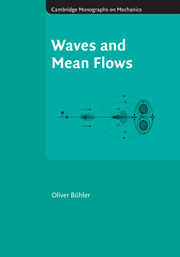Book contents
- Frontmatter
- Contents
- Preface
- Part I Fluid Dynamics and Waves
- Part II Wave–Mean Interaction Theory
- 5 Zonally symmetric wave–mean interaction theory
- 6 Internal gravity waves
- 7 Shear flows
- 8 Three-dimensional rotating flow
- 9 Rossby waves and balanced dynamics
- 10 Lagrangian-mean theory
- 11 Zonally symmetric GLM theory
- Part III Waves and Vortices
- References
- Index
9 - Rossby waves and balanced dynamics
from Part II - Wave–Mean Interaction Theory
Published online by Cambridge University Press: 29 March 2010
- Frontmatter
- Contents
- Preface
- Part I Fluid Dynamics and Waves
- Part II Wave–Mean Interaction Theory
- 5 Zonally symmetric wave–mean interaction theory
- 6 Internal gravity waves
- 7 Shear flows
- 8 Three-dimensional rotating flow
- 9 Rossby waves and balanced dynamics
- 10 Lagrangian-mean theory
- 11 Zonally symmetric GLM theory
- Part III Waves and Vortices
- References
- Index
Summary
We now turn to wave–mean interactions involving Rossby waves, the peculiar vorticity waves whose linear dynamics was described briefly in §4.2.2. Unlike acoustic waves or gravity waves, the dynamics of Rossby waves is essentially linked to the layerwise advection of PV, and this gives the mathematical description of Rossby waves and of their interactions with a mean flow a very special character.
The easiest model in which to study this topic is the quasi-geostrophic approximation to the shallow-water equations on a β-plane. However, the results easily generalize to three-dimensional stratified flow.
Quasi-geostrophic dynamics
We have no interest in gravity waves in this chapter and therefore we use the simplest theoretical approximation that filters these waves whilst retaining the balanced flow structure of Rossby waves and shallow-water vortices. This is accomplished by the quasi-geostrophic approximation to the equations, which is essentially a nonlinear extension of the linear balanced mode. These equations use a single dynamical variable, namely the PV.
Overall, the use of PV and of balanced flow systems based on PV advection and PV inversion (such as the quasi-geostrophic equations or its many variants) are key concepts in atmosphere ocean fluid dynamics. For instance, balanced models were an essential component of the first successful numerical weather forecasts. Such a direct quantitative use of balanced models is less important today, but the insights that can be gained from studying such reduced dynamical systems remains as valuable as ever.
- Type
- Chapter
- Information
- Waves and Mean Flows , pp. 186 - 203Publisher: Cambridge University PressPrint publication year: 2009

